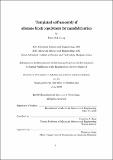Templated self-assembly of siloxane block copolymers for nanofabrication
Author(s)
Jung, Yeon Sik
DownloadFull printable version (11.28Mb)
Other Contributors
Massachusetts Institute of Technology. Dept. of Materials Science and Engineering.
Advisor
Caroline A. Ross.
Terms of use
Metadata
Show full item recordAbstract
Monolayer patterns of block copolymer (BCP) microdomains have been pursued for applications in below sub-30 nm nanolithography. BCP selfassembly processing is scalable and low cost, and is well-suited for integration with existing semiconductor fabrication techniques. The two critical issues are how to obtain reliable long-range ordering of features with minimum defect densities and how to successfully transfer the patterns into other functional materials. Exceptionally well-ordered and robust nanoscale patterns can be made from poly(styrene-b-dimethylsiloxane) (PS-PDMS) BCPs, which have a very large Flory-Huggins interaction parameter between the blocks compared to other commonly used BCPs. Cylinder- or sphere-forming BCP films were spincoated over silicon substrates patterned with shallow steps using optical lithography or nanoscale posts made by electron-beam lithography, and solvent-annealed to induce ordering. This generates patterns with a correlation length of at least several micrometers. The annealed film was treated with plasma to obtain oxidized PDMS patterns with a lateral dimension of 14 - 18 nm. These can be used as an etch mask or an easily removable template for patterning functional materials. Solvent vapor treatments can tune the pattern dimension and morphology. Different degrees of solvent uptake in BCP films during solvent-annealing can manipulate the interfacial interaction between the two blocks, and a mixed solvent vapor can change the effective volume fraction of each block. The self-assembled patterns can be transferred into various kinds of functional materials. (cont.) For example, arrays of parallel lines were used as a mask to pattern poly(3,4-ethylenedioxythiophene):poly(styrenesulfonate) (PEDOT:PSS) conducting polymer thin films. The resulting PEDOT:PSS nanowire array was used as an chemiresistive-type ethanol-sensing device. Metallic films such as Ti, Pt, Ta, W, and magnetic Co and Ni were structured using a pattern-reversal process. Coercivity enhancements were observed for the fabricated ferromagnetic nanostructures such as wires, rings, and antidots. These functional nanostructures can be utilized for a variety of devices such as high-density and high performance sensor or memory devices.
Description
Thesis (Ph. D.)--Massachusetts Institute of Technology, Dept. of Materials Science and Engineering, 2009. This electronic version was submitted by the student author. The certified thesis is available in the Institute Archives and Special Collections. Cataloged from student submitted PDF version of thesis. Includes bibliographical references.
Date issued
2009Department
Massachusetts Institute of Technology. Department of Materials Science and EngineeringPublisher
Massachusetts Institute of Technology
Keywords
Materials Science and Engineering.